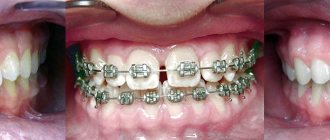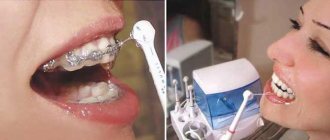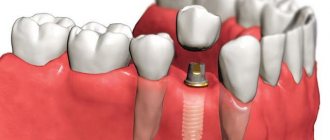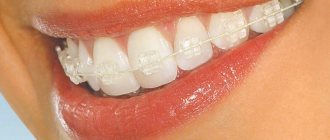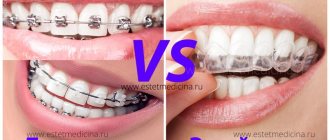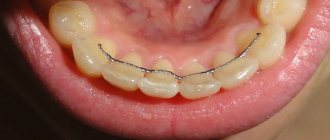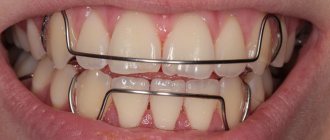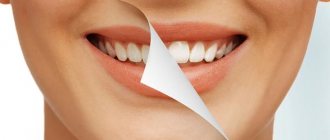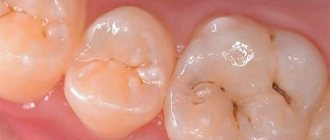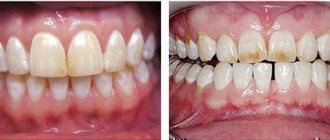What to do before installation?
Before starting treatment, it is necessary to undergo special diagnostic procedures (taking impressions, making jaw models, x-ray examination of the dentition and skull bones). They are necessary for making a final diagnosis and correct treatment planning.
Before fixing braces, it is important to carry out professional hygiene and treatment of all teeth. There should be no carious cavities. Next comes the stage of fixing braces and orthodontic treatment.
Constant problems of “temporaries”. Do baby teeth need to be treated? More details
Myth 2. Age affects the ability to be treated with braces.
Many patients are surprised that they can be treated with braces at 30, 40, 50, 60 and 70 years old! And in general at any age.
DETAILS: At what age do children get braces and what types are there?
There are two categories of orthodontic patients:
- The patient is at the stage of jaw growth, peak growth usually occurs at 11-12 years of age.
- The patient is no longer growing - he has a full set of teeth and jaw growth has stopped, most often he is 15-16 years old and older.
In the first case, the orthodontist works with the teeth and jaw, in the other - only with the teeth. At the stage of stopped growth, jaw correction can only be performed by an orthognathic surgeon. But there are no age restrictions for aligning the dentition and correcting the bite.
Claims regarding the harm caused by installing and wearing braces are in most cases unfounded. They are usually distributed by people who are not fully familiar with the corrective design, based only on their guesses and judgments.
These statements are of the following nature:
- braces spoil the enamel;
- prevent tooth growth during adolescence;
- lead to the development of caries and gum inflammation;
- provoke processes of demineralization of tooth enamel.
Some of these statements are true, but only 15-20%. Such problems can arise even in those people who have never worn braces. The risk of developing disorders is due to bad habits, violation of oral hygiene rules, and untimely visits to the dental office.
The factor in which the harm of braces becomes real is the negligence or incorrect actions of the doctor. We are talking about inaccurate installation of a braces system, during which tooth enamel is damaged or even the structure of the integrity of the tooth is disrupted. This also includes an incorrectly selected brace system, which will not solve the patient’s problem or even lead to its aggravation. To prevent this from happening, it is important to contact only experienced dentists in good clinics.
Correction of various dental pathologies by installing braces places a certain responsibility on the patient. It lies in the need to pay more attention to oral hygiene. If, after installing braces, a person does not follow proper hygiene rules and does not take care of the system and his teeth, the likelihood of problems also increases.
Otherwise, treatment with braces is the safest procedure possible. It allows you not only to take care of the beauty of your teeth and smile in the future. Braces solve serious problems with bite and crooked teeth. You should not succumb to unfounded judgments, causing harm to your health.
Wearing a brace system is accompanied by a number of disadvantages, but most of them are relative:
- Painful sensations. Installation of braces, if done by an experienced doctor and the patient sits calmly during the procedure, is painless. The patient may experience pain while wearing the braces system, but mainly in 1-2 weeks after their installation, this is how long the adaptation period lasts. Pain occurs due to the pressure that braces place on the teeth, but this is how alignment occurs. During the adaptation period, the patient gets used to the pressure and the pain becomes invisible.
- Discomfort is hardly harmful. Wearing braces changes your pronunciation somewhat and is accompanied by unusual sensations, but this also goes away after 1-2 weeks. Constant discomfort is caused only by spending more time on hygiene procedures and the fact that braces can be visible to others.
- Allergic reactions. Allergies are possible, with individual intolerance to the materials from which the structure is made. In such cases, it is recommended to first take a blood test for allergens in order to subsequently select a material for making braces that will not cause allergies. The second solution is to initially select hypoallergenic materials, including designs made of gold and sapphire.
- Root resorption is a pathological condition characterized by a reduction in the roots of teeth. Braces contribute to a slight shortening of the roots, but do not directly provoke the development of pathology. Resorption can develop in a person who does not use an orthodontic device. Unfortunately, it is almost impossible to identify predisposition in advance.
- Development of diseases of teeth and gums. Wearing braces actually contributes to the development of various diseases, as it becomes more difficult to maintain oral hygiene. Insufficient cleaning of teeth, gums and hard-to-reach areas of the structure leads to the proliferation of bacteria that contribute to the development of infectious lesions. But this is a purely human factor, if you pay due attention to hygiene and use special cleaning devices (brushes and spatulas), this problem fades into the background.
- Damage to the oral mucosa. Perhaps the only real disadvantage of installing braces. If the structure is installed on the outer projection of the dentition, there is a high probability that they will rub the cheeks and lips. But in case of such troubles, ask your doctor to install silicone protective elements or give out special wax. They are soft and protect oral tissues from chafing and other damage.
There is an assumption that braces have a harmful effect on the enamel, causing caries, causing demineralization of the enamel. In fact, negative processes can occur due to insufficient hygiene due to the formation of dental plaque that provokes infections. With high-quality installation and proper care, no negative effects of braces on the enamel and dental health have been identified.
Many myths are associated with the disadvantages of orthodontic treatment with braces, which actually exist, as well as with the features and disadvantages of individual braces. If we leave aside the aesthetic side of the issue, the main disadvantage of wearing braces is some complication of hygienic requirements.
DETAILS: How to relieve pain from braces
To refute the most common myths and speculations about the dangers of braces, it is worth taking a closer look at the reasons for the appearance of some of them:
- Pain and discomfort. Braces cause some discomfort only in the first days after installation; as a result of pressure on the teeth, unusual sensations arise that soon pass. The gums may ache slightly, itch, different options are possible - the intensity and type of pain depends on the individual characteristics and complexity of each specific case, but most often the side effects are minimal and fleeting. Professional recommendations from your dentist will help you quickly eliminate any discomfort. The bite correction procedure itself is stressful for the body, so some symptoms are completely normal, adaptation to new conditions and sensations occurs quite quickly. After about a week, braces stop bothering you and simply become a normal part of your life.
- Braces are harmful to teeth. There is no direct evidence of this statement over the many years of existence of modern structures - braces themselves are absolutely safe, providing a gentle correction of the position of the teeth. Only the person himself during the treatment process can provoke dental problems if he is negligent in following the recommendations of the treating specialist. Insufficient quality hygiene can provoke the accumulation of plaque, which is the cause of stomatitis, caries, gingivitis and other unwanted diseases.
- Braces damage the enamel. If we are talking about the dangers of installing systems for enamel, it is necessary to identify all possible problems and eliminate them at the stage of examination and preparation. If the condition of the teeth initially indicates a lack of minerals, in order not to aggravate the problem, the doctor prescribes special procedures to prevent the threat of erosion. This must be done before installing an orthodontic appliance.
- Braces cause allergies. Contraindications of this kind occur; most often they are associated with the presence of gum disease or the body’s specific rejection of certain materials. To safely use orthodontic appliances, it is necessary to eliminate treatment-related problems in the mouth. There are special braces with a biologically neutral composition - gold, sapphire, which are an ideal material for all risk categories - allergy sufferers, people with gastrointestinal diseases and others.
What types of braces are there?
Braces systems can be divided into two large groups: metal - made of metal, and aesthetic - made of ceramics.
Metal braces are universal - they can be used in all cases: from the simplest to the most complex. These braces are made of medical steel and contain nickel. For patients with increased sensitivity to nickel, titanium-coated braces are available.
The main advantage of metal braces is the high strength of their structure. In addition, metal braces have better friction. The speed of treatment may depend on it. Therefore, in the vast majority of cases, metal braces need to be worn less than ceramic braces. These braces also do not change color throughout the entire treatment and are cheaper.
Aesthetic braces, unlike metal ones, are white or even transparent. This allows them to match the color of your teeth as much as possible. They are not noticeable when smiling and talking. Sometimes aesthetic braces are called “sapphire” braces. “Sapphire” braces are a type of ceramic braces. They are made from single crystal artificial sapphire.
To create more standard specimens, polycrystalline ceramics are used.
Aesthetic braces are not stained throughout the entire treatment period. In addition, they are hypoallergenic, which gives them an advantage over metal ones if the patient has increased sensitivity to metals. The disadvantages of aesthetic braces include their high cost. Additionally, increased system friction may increase active treatment time.
There are options for combinations of braces. The most commonly used ceramic braces are for the teeth of the upper jaw and metal braces for the teeth of the lower jaw. This way they are less noticeable and cost more humanely.
Hollywood smile. Do adults need to have their teeth straightened? More details
Myth 5. After the plate in childhood, braces are not needed
If a patient had treatment with a plate or partial braces in childhood, this does not always guarantee avoidance of orthodontic treatment in the future. Very often during consultations we hear from parents of teenagers that they previously had treatment with braces, in which case it is quite difficult to explain the need for repeated treatment. You need to understand that orthodontic treatment can be carried out in several stages. The first stage is in childhood with the help of a plate or partial braces, and the second stage is in adolescence, already at the stage of permanent dentition.
How are braces fixed?
Depending on the method of fixation, braces can be of two types.
Vestibular braces are fixed to the front (vestibular) surface of the teeth. They are visible to others, especially metal systems. Getting used to external braces goes quickly. Injuries to the mucous membrane are rare. Difficulties in pronouncing sounds are rare.
Lingual braces are fixed to the inner surface of the teeth. The impetus for their creation was the need to make bite correction invisible to others. Getting used to lingual braces can be much more difficult. The design often rubs the tongue. There are problems with diction. The adaptation period can last from two weeks to several months.
Article on the topic
Caries will lead to a stroke. What are the dangers of untreated teeth?
Do braces damage tooth enamel?
There is an opinion that wearing braces damages teeth and leads to caries. It is not true.
Wearing braces is not the cause of caries, the reason that after their removal the teeth are destroyed, become weaker, etc. But a certain dependence can be traced: “If the braces are removed, the teeth are affected by caries.” Why is this happening? This is all due to insufficient hygiene, irregular or lack of home procedures to strengthen and nourish teeth.
What to do so that after removing braces you do not have to treat caries
Before installing braces, all teeth must be treated.
Immediately before fixing braces, professional hygiene should be carried out. After brushing, you should not coat your teeth with fluoride varnish. This will complicate the process of fixing the “clasps” to the teeth.
It is advisable to carry out professional hygiene every 3-4 months while wearing braces, followed by coating all teeth with fluoride varnish.
At home, brush your teeth with a brush and toothpaste. There are special toothbrushes for those who wear braces.
Use special brushes after each snack to remove all food debris from under the arches.
Regularly use remineralizing products after cleansing. Apply to teeth twice daily after brushing. They nourish dental tissues with calcium, phosphorus, and magnesium. Additionally protects against caries.
Sweets are not harmful? Five myths and facts about tooth decay Read more
Features of caring for the braces system
This is a complex of locks: each lock is glued to a special dental material exactly on the center of the tooth. After gluing, a special metal arc is threaded through all the locks (there is a groove in the middle of each one), then, depending on the model and type of system, the arc is fixed in each lock in different ways - either the lock is simply closed with a special latch, or a small rubber band is put on top of it, or it is wrapped with thin wire.
It happens that additional means are used to create free space for a tooth or if it is severely displaced. In this case, a special strong directional thrust is needed: then the orthodontist uses additional means: rubber rods (elastic bands), buttons for fixing the rubber rods, springs that are placed on the arch.
The braces system itself is a metal structure that is glued to the surface of the teeth without damaging the enamel. The enamel is not sawed into locks or polished; a special light-curing material containing fluorine (to prevent caries) is glued onto a clean and healthy surface. Thus, it becomes clear that the braces system does not damage the teeth.
The first thing you need to do before installing the structure is to find out what awaits you in the next 1–1.5–2 years (depending on the type of brace system chosen and the initial situation in the oral cavity).
- Dental care is required daily. But if without any devices it is enough to brush your teeth 2 times a day: in the morning and in the evening, then with braces you will need to brush them after every meal and a toothbrush will not be enough for high-quality cleaning.
- You will need an additional hygiene product: an irrigator (for rinsing and cleaning hard-to-reach places). This may seem too complicated... but believe me, the result is worth the joint efforts - yours to care for the structure and teeth and the orthodontist to correct the bite.
- You need a special toothbrush - orthodontic, it has a groove (indentation) in the middle row of bristles. That is, different lengths of the bristles: the bristles are longer at the edges, and shorter in the center. So that the side rows of bristles can reach the teeth, and not hang in the air due to the fact that the brush rests against the braces. Therefore, your regular brush will not be useful after installing the structure. Movement of the toothbrush – forward/backward (since the brush cannot move freely over the teeth, the metal structure interferes with it).
- A single-tuft toothbrush may be needed. This is a very small round brush that cleans one tooth at a time in places where a regular toothbrush cannot reach or is very inconvenient to do.
- There are special toothpastes for people with braces, they are called “orthodontic” or ortobracketsamp;orto and differ from ordinary ones in that they clean the surface better (more foamy), plus they contain xylitxylitol - the most active component for the prevention of caries, for its suspension.
Xylitol is a substance obtained from birch, a sweetener, carious microbes absorb it (they feed on sweets), but cannot digest it and die. Thus, this is the most physiological and targeted way to combat caries. The balance of microflora in the oral cavity is not disturbed, unlike antiseptics such as triclosan - it kills all microflora in the oral cavity, including useful ones, which help digest food and protect us from bacteria and viruses.
There are some dietary restrictions with the braces system, they are associated with two points:
- Hard food can tear off the bracket (lock) - for example, it is not recommended to bite off a whole apple, carrot, or chew crackers. You can cut apples or carrots into pieces so you can immediately chew them on your back teeth.
- Soft and sticky food clings to the locks and the arch, and it is difficult to clean it out; walking with food on braces is not aesthetically pleasing. In addition, if you have a snack somewhere “on the go” and you don’t have enough time to clean out stuck pieces after eating for 10 minutes, then it is better to exclude from your diet: soft pastries, chewing candies, toffees, products with poppy seeds, etc. .
I hope that from all that has been said it becomes clear that the harm is not from dental braces, but from poor care of them while wearing the system and lack of information from the dentist.
What after braces?
After achieving the desired result, the braces are removed. But the work on a beautiful smile does not end there. Now you need to “force” the teeth to remain in the same position. This is the task of retainers and aligners. A retainer is a metal wire that is placed on the inside of the front central teeth. It is secured using a special filling material. Serves as a kind of stabilizer and prevents teeth from moving apart.
A mouthguard is a completely transparent lining that fits tightly to the tooth enamel. Made from biopolymer materials. This eliminates the risk of allergic reactions.
Mouth guards are comfortable to wear and invisible to others.
The teeth must get used to the new position, because the body constantly resists and demands that everything be returned to its place. If you neglect to install retainers or aligners, the results from wearing braces for many months can quickly disappear.
Causes of white spots
The main factors influencing the formation of white spots on teeth after wearing braces include poor oral hygiene and the influence of genetics. There is no clear plan of action to combat the complication, but there are opportunities to minimize such manifestations. At the same time, it is worth taking a closer look at changing your diet and regular preventive procedures at home and in the dentist’s chair. Bacteria lead to the fermentation of carbohydrates and the synthesis of acids in the mouth. In this connection, the phenomenon of decalcification occurs, as well as the appearance of white spots. Various sweets are rich in carbohydrates, for example, buns, candies, carbonated juices, etc. If you abuse these products and do not thoroughly clean your teeth after eating, the above-mentioned pathological processes are triggered. You should definitely get advice from your doctor regarding nutrition. He can additionally suggest which foods are best avoided and which ones to give preference to. The orthodontist will also give recommendations on home hygiene methods and the selection of teeth cleaning products. Particular attention should be paid to special brushes and brushes for braces, as well as an oral irrigator.

